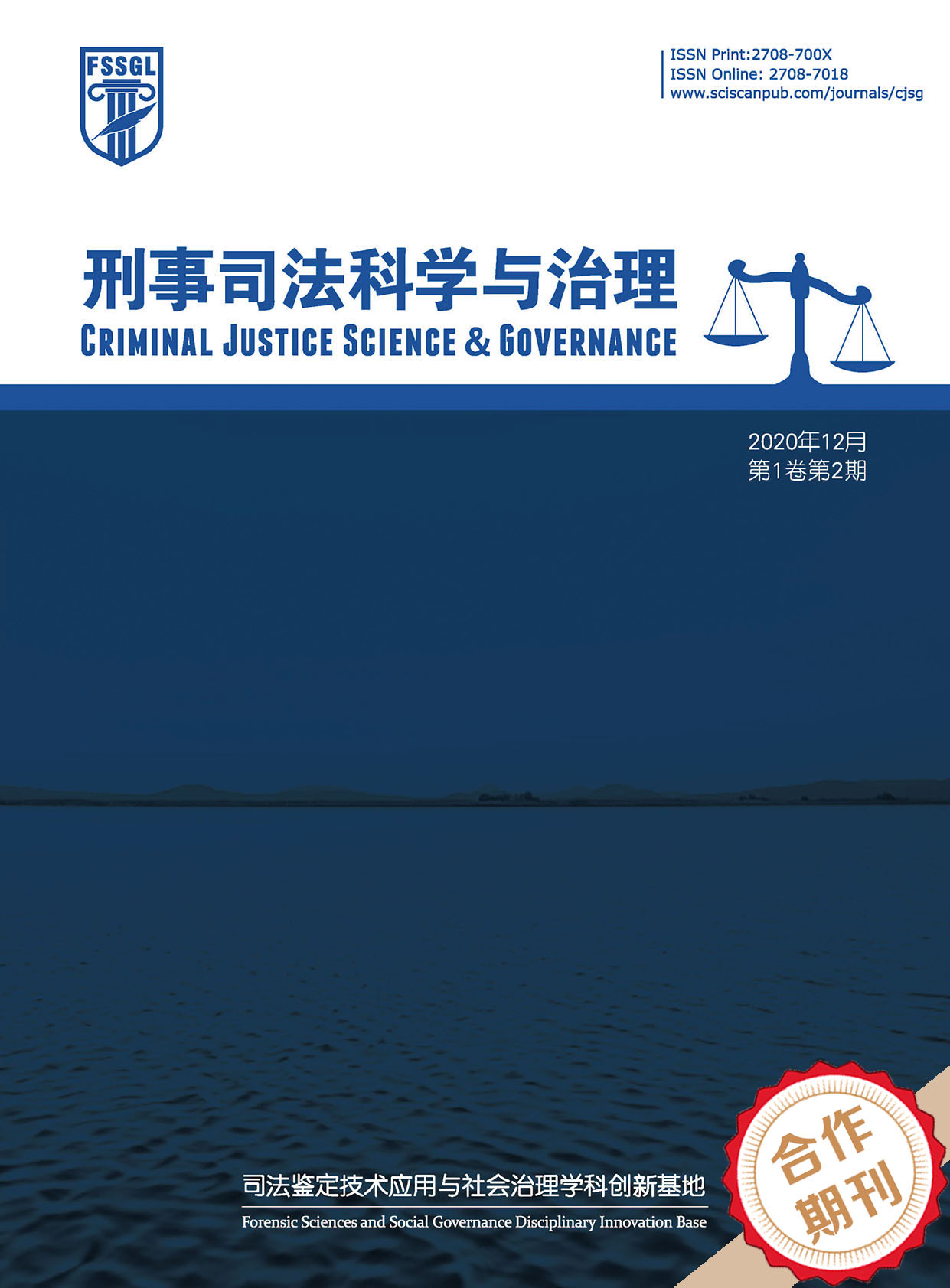Criminal Justice Science & Governance
“虚假信息型”网络寻衅滋事犯罪司法适用困境与出路
Dilemma and Way Out of Judicial Application of “False Information Type” Network Affray Crime
- Authors: 王彦翔
-
Information:
北京师范大学法学院,北京
-
Keywords:
Cybercrime; Affray; False information; Judicial application; The risk of recidivism网络犯罪; 寻衅滋事; 虚假信息; 司法适用; 再犯风险
- Abstract: In the digital age, the problem of cybercrime is becoming increasingly severe. The “false information type” network affray crime is expanding at an accelerating rate. There is a lack of specific and unified legal application standards for this type of crime. In order to better address the numerous issues existing in the current judicial application of such crimes, this study focuses on the “false information type” network affray crime. Starting from the research status at home and abroad, it summarizes the characteristics of this type of crime, including strong concealment, low cost, rapid information dissemination, direct impact on real-life, and the trends of being organized and professionalized. Through the analysis of specific cases such as those of Qin Moumou and Zhong Moumou, the following four dilemmas in judicial application are summarized: The scope of false information, the determination of “serious disruption of public order”, the balance between illegal costs and the risk of recidivism, as well as the ambiguity of conviction and sentencing boundaries and the lack of standards. To cope with the above-mentioned dilemmas, six targeted measures are proposed in this study: Clarify the scope of false information and strictly distinguish false information from facts and opinions; construct a determination system for “serious disruption of public order”, comprehensively consider multiple factors and quantify the standards; increase illegal costs and reduce the risk of recidivism from the civil and administrative levels; Give play to the guiding role of legal interpretations and guiding cases; Construct a smart judicial element-based trial-assistance model to assist in judicial decision-making; Establish a multi-party participation supervision mechanism for collaborative governance among network platforms, regulatory authorities, and judicial organs, strengthen the supervision of key netizens, and prevent crimes. 在数字时代,网络犯罪问题日益严峻,“虚假信息型”网络寻衅滋事犯罪呈加速扩张态势。该类犯罪缺乏具体、统一的法律适用标准,为了更好解决目前该类犯罪司法适用中存在的诸多问题,本文聚焦“虚假信息型”网络寻衅滋事犯罪,从国内外研究现状出发,归纳总结该类犯罪隐蔽性强、成本低、信息扩散快且直接影响现实生活、组织化和职业化的特征。结合秦某某、钟某等具体案例分析,总结出以下四点司法适用困境:虚假信息范围、“公共秩序严重混乱”判定、违法成本与再犯风险平衡以及定罪量刑界限模糊、标准缺失。为应对以上困境,研究提出六点针对性措施:明确虚假信息范围,严格区分虚假信息与事实、意见;构建“公共秩序严重混乱”认定体系,综合考量多种因素量化标准;从民事、行政层面提升违法成本、降低再犯风险;发挥法律解释与指导性案例的指引作用;构建智慧司法要素式审判辅助模型,助力司法决策;建立网络平台、监管部门、司法机关协同共治的多方参与监管机制,加强对重点网民的监管并预防犯罪。
- DOI: https://doi.org/10.35534/cjsg.0601006
- Cite: 王彦翔.“虚假信息型”网络寻衅滋事犯罪司法适用困境与出路[J].刑事司法科学与治理,2025,6(1):49-56.
一、引言
数字时代的网络技术为人们的生活带来极大便捷的同时,也让网络犯罪成为了社会治理的时代难题。“虚假信息型”网络寻衅滋事犯罪近年来引起公众的广泛关注。从早期的个别网民为了博眼球、泄私愤编造传播虚假信息,到个别博主为了获取关注、谋取利益编造传播虚假消息引发网络舆论,再到如今有组织、职业化的网络水军受利益驱使,在网络平台上肆意编造传播虚假消息,都对网络秩序、社会风气造成了恶劣的影响。
国外在此类犯罪的立法与实践方面已经积累了较为成熟的经验。美国针对网络犯罪构建了多层次的法律体系,涵盖联邦法律与各州法律。在网络虚假信息相关领域,其法律着重平衡言论自由与犯罪惩治之间的关系。在一些具体的网络犯罪立法中,美国强调对虚假信息传播行为的精准打击。当虚假信息传播涉及欺诈、侵犯隐私等严重损害他人权益的行为时,法律会给予严厉制裁。欧盟建立了一套较为完善的谣言治理机制,其中信息发布者责任制度、多主体协同治理模式以及快速反应机制颇具特色。在信息发布者责任制度方面,欧盟要求网络平台对用户发布的内容进行一定程度的审核,若平台未能尽到审核义务,对谣言传播起到促进作用,则需承担相应责任。在多主体协同治理上,欧盟注重政府、网络平台、社会组织和公众的共同参与。快速反应机制则强调在谣言出现后,各方能够迅速行动,及时发布权威信息,澄清事实,减少谣言的负面影响。
我国也对网络寻衅滋事犯罪进行了一定的研究,但针对“虚假信息型”这一特定类型的研究仍有深入空间。2013年“两高”出台的《关于办理利用信息网络实施诽谤等刑事案件适用法律若干问题的解释》,为打击此类犯罪提供了一定的法律依据,但目前该罪名在我国法律中仍属于一个相对模糊的罪名,特别是对于《刑法》第二百九十三条第一款第四项“公共秩序严重混乱”缺乏具体、统一的法律适用标准。因此,《网络诽谤解释》第五条的规定将网络空间解释为公共场所,凡是在网络上发布的言论、图片或者视频,引起他人的点赞、评论、转发,都可能进入寻衅滋事罪的法网,造成司法适用中不易区分出罪界限与入罪界限,由此形成一系列司法适用的难点亟待进一步解决。
二、“虚假信息型”网络寻衅滋事犯罪的特征
(一)行为隐蔽性强
网络空间不同于公共场所,这种虚拟空间中现实身份无法与网络身份一一对应。尽管当前推行网络实名制,但在尚未全面落实前,仍然存在不少以网名或者匿名的方式登录、使用网络平台的情况。在不能确定发布者或传播者身份的前提下,一些近乎真实但实为虚假的信息更显得真假难辨。以当前受众非常广泛的微信为例,如果行为人购买他人微信账号,在微信群中制造、发布虚假信息,对于普通信息受众而言,很难辨别其真假。
(二)行为成本低
如今互联网上的信息纷繁复杂、内容多样,网络寻衅滋事案件中的行为人通常就地取材,主要采取对网上已有的信息进行改造和加工的方式,使得信息变得半真半假、混淆视听,以便达到博人眼球的效果。信息的传播已经不受时间和空间的限制,在数字时代,一个账号加上一台电脑或一部手机就可以在网络上发布信息,一旦信息发布就能在瞬间形成传播效应。即便在传播当时并没有掀起轩然大波,引发蝴蝶效应,传播者也可以通过购买“水军”、热搜等方式换取流量、扩大传播范围,更有甚者还可以对信息进行控评。实践中也存在不少在没有任何来源的情况下无中生有捏造信息的情况,以达到编造者的目的。随着诸如H5平台等文字、图形处理软件技术的兴起,出现了诸多利用“深度合成”等生成式人工智能技术发布违法信息的情况。例如,某些博主为了获取流量,利用简单的图片处理软件和文字编辑工具,编造明星绯闻等虚假信息,仅需花费少量时间和精力,却能在短时间内获得大量关注和广告收益。这说明具有基础电脑知识的人就可以编造出虚假的信息,大大降低了违法犯罪的成本。
(三)网络信息直接影响现实生活
有学者认为,互联网的出现和普及使得犯罪发生的空间变为网络空间加现实空间。事实上,这种“双层社会”已经形成并客观存在。网络社会与现实社会是紧密联系的一体,现如今人们的日常生活普遍离不开网络空间,网络寻衅滋事行为虽然发生在网络空间,但行为之目的也包含对现实生活造成影响,因此最终寻衅滋事行为所侵害的法益仍是现实世界的法益。“虚假信息型”网络寻衅滋事行为因未受到强力抑制而仍在持续膨胀,作为一种极具危害性的社会问题直接影响整个现实社会,会助长网络不良风气、激化矛盾、破坏信任、催生网络犯罪等。例如,在秦某某网络寻衅滋事案中,“7·23”甬温线动车事故处理期间,其为了利用热点事件进行自我炒作,提高网络关注度,编造并散布虚假信息,称原铁道部向在此次事故中身亡的外籍旅客支付3000万欧元高额赔偿金。该微博被转发11000次,评论3300余次,不仅造成网络空间的混乱,也在现实社会引发不明真相群众的不满,扰乱了政府机关的善后工作。其还通过互联网捏造了诸多虚假信息,严重扰乱了网络秩序和现实生活。例如,他捏造中国残联主席拥有日本国籍,对我国某著名军事专家进行无中生有的恶意中伤,称其哥哥在德国西门子公司任职等。现如今,为了炒热度、博眼球,故意剪辑拼凑视频片段在网络上层出不穷,更有甚者博主故意引发粉丝群体之间的骂战,造成社会舆论的混乱,或者发表煽动性言论,如教唆观众对特定企业、机构或个人进行攻击骚扰,或者传播未经证实的谣言,导致大量观众在不明真相的情况下参与其中,严重扰乱网络秩序和社会安宁。
上述信息后续将带来直接的现实影响。除了现实生活的直接影响外,更大程度上还是通过纷繁混乱、戾气十足的网络秩序激发其他网民的负面情绪,甚至影响网民的思维方式与行为习惯,发动网民用狭隘的价值观攻击他人。
(四)信息扩散迅速
在传统方式下,制造和传播虚假信息受制于时空条件以及传播方式,往往需要投入大量人力、物力和财力,但其扩散效果并不理想。然而,借助网络平台,信息的制造和传播都更为简便。网络信息最为明显的特点是可以达到瞬时传播的效果,网络热点事件能在短时间内吸引大量网民的关注。寻衅滋事者会敏锐地捕捉这些热点,故意歪曲事实、编造谣言,并借助热点事件的热度迅速传播。例如,在自然灾害发生后,编造救援不力、物资被挪用等虚假信息,引发公众对政府救援工作的质疑和不满;在明星绯闻或社会争议事件中,恶意揣测、编造当事人的隐私信息并大肆传播,不仅侵犯他人名誉权等合法权益,还会使网络舆论环境陷入混乱和低俗,严重破坏网络文明生态。这些虚假信息借助热点事件的传播力,往往能在极短时间内扩散到各个网络角落,造成难以估量的社会影响。
(五)有组织化、职业化趋势明显
“虚假信息型”网络寻衅滋事犯罪呈现出有组织化、职业化的特点。出现了网络水军群体,甚至成立了专门的业务公司,他们受雇于特定利益集团或个人,在网络寻衅滋事活动中扮演着重要角色。网络水军会有计划地在各大网络平台发布虚假信息、恶意评论、刷量控评等。例如,在某企业产品质量争议事件中,水军可能被竞争对手雇佣,在电商平台的产品评论区大量发布虚假差评,同时在社交媒体上传播该企业的负面谣言,试图误导消费者,破坏企业声誉和正常经营秩序。在一些涉及社会公共议题的讨论中,水军通过在不同立场的网民之间挑起争端、制造对立,故意使讨论偏离理性轨道,阻碍真实信息的传播和问题的解决,严重干扰网络舆论的正常引导功能和社会治理进程。2023年11月23日,钟某因网络寻衅滋事被立案调查。钟某于2023年9月注册登记某信息科技公司,并在网络平台注册“钟某讲财商”“钟某讲置业”等130余个账号。为吸引粉丝、博取流量,该公司专门从网络上收集热点信息,进行编辑后再予以发布,还组织员工大量转发,以吸引网络受众浏览,通过网络流量和关注度来获取收益。截至2023年12月6日,其编造的“温州帮竟然是缅北电诈的后台”虚假视频信息总计播放量为324.9万次,被点赞11.8万次,被评论1.2万次,被转发12.1万次,被收藏2.5万次,造成了恶劣影响,严重扰乱了社会公共秩序。
三、“虚假信息型”网络寻衅滋事犯罪司法适用的困境
(一)虚假信息认定的“迷雾”
准确认定利用信息网络实施寻衅滋事罪的重点在于是否编造、传播了虚假信息。关于虚假信息的认定标准,从现行法律规定来看,《网络诽谤解释》颁布的背景是出现了诸多利用网络制造、传播谣言的现象。当前我国对于虚假信息的治理体系中,对于虚假信息的法律表述及判定标准较为模糊,从而无法准确界定其范围。有的学者认为,如果仅停留在道德范畴,不涉及法律责任的承担问题,那么依据人们内心的朴素情感,对那些无中生有、编造伪造、恶意揣测、肆意谩骂、故意诋毁的“言论”,每个人均可以自由地作出自己的善恶评判。但在法律框架内,涉及法律责任的有无和大小、制造与传播谣言的司法认定,使其变得严肃而复杂。事实上,在判定是否为虚假信息时,往往还是从价值评价着手,对其信息真实性所占比例、表达含义是否发生质的变化、其内容输出强度对社会认知所产生的影响力大小等方面综合进行辨别,进而与事实判断作出区分。例如,当人们陈述“地球是方的”,如果讲述该内容的语境为课堂上学生对问题的回答,那么从大众认知来说,这只是一种学生对未知事物的事实判断。虽然其真实性为假,但是并不会对社会认知造成影响,但如果这句话是社交媒体账号为了博取流量发出,并配上所谓的数据、卫星云图等资料进行佐证,那么这时就是一种价值评价,其表达含义已经发生了质的变化,是一种没有事实依据且脱离了大众认知的信息。当该信息具有一定社会影响力时,其对于社会的影响是不容忽视的。正是因为信息在不同的语境中有着不同的解读,所以在判定虚假信息时存在一定的困难,必须结合多重因素加以判断,从而进一步判断是否构成网络寻衅滋事犯罪,形成完善的证据链条和详实、逻辑缜密的裁判说理。
(二)“公共秩序严重混乱”判定难
“造成公共秩序严重混乱”是网络寻衅滋事犯罪的结果要件,而结果要件是指衡量法益侵害程度的一种外在具化。特定行为侵害了刑法上保护的法益,这种侵害程度需要借助结果要件加以衡量和确定。从网络寻衅滋事罪的适用来看,“口袋罪”趋势越发明显。寻衅滋事行为原本用于规制在现实生活中频发的打架斗殴、聚众闹事以及随意破坏公私财物的行为,对于肉体上的暴力具有较强的针对性。但在网络空间的场景下,网民针对社会热点人物的口诛笔伐并不必然导致公共秩序的破坏。广大网民通常是以站在道德制高点的姿态对处于舆论漩涡中的当事人进行谴责,主观上并不必然具有恶意,有的甚至自认为是在伸张社会正义,充分行使自己的言论自由权利。
作为网络寻衅滋事犯罪的结果要件,“造成公共秩序严重混乱”的表现方式无疑是复杂多变的,现行法律中对于其统一的认定标准处于缺失状态,因此在司法适用中对于裁判者的主观判断依赖性很大。“造成公共秩序严重混乱”的实质即行为人所散布的虚假信息被大量转发、评论或者被媒体报道,混淆视听,蛊惑群众,严重扰乱生产、生活等社会秩序。但是,虚假信息被大量转发、评论的追诉标准目前没有具体规定,司法实践中主要参照《解释》第二条规定的“同一诽谤信息实际被点击、浏览次数达到五千次以上,或者被转发次数达到五百次以上”的规定进行认定。
(三)违法成本与再犯风险的“失衡”
不论是民事侵权责任的承担,还是行政处罚与刑事入罪,目前对“虚假信息型”网络寻衅滋事的规制模式还不足以强有力地打击行为人。首先,从民事侵权责任角度来看,虽然《民法典》规定了受害方可以就虚假信息所遭受的侵害向侵权者提起诉讼,但需要注意的是,在民事诉讼中采取的是“谁主张谁举证”的举证责任分配规则。从实际情况来看,虚假信息造成的侵权案件一直存在举证难的问题。侵权人大多在网络采用匿名或昵称发布信息,一人可以有多个账号,如果仅根据账号信息来精准找出背后的侵权人,对于受害人个人来说难度过大。即便通过技术手段找到背后的侵权人,要证明其主观故意、对受害人造成的实际损失也需要耗费大量精力,这也就导致不少受害者选择放弃维权。其次,从行政处罚角度来看,《治安管理处罚法》中规定的“危害社会秩序”认定不统一,导致实际处罚标准不统一。行政处罚大多是以行政拘留和罚金的形式,但行政拘留最长不超过20日,罚金也并不算高,被处罚人再犯的可能性极大。
(四)定罪量刑界限模糊、标准缺失
网络寻衅滋事行为可能与诽谤罪、侮辱罪、编造、故意传播虚假信息罪等罪名存在竞合或界限模糊的情况。在网络上编造并传播虚假信息的行为,既可能符合寻衅滋事罪中“编造、散布虚假信息,起哄闹事,造成公共秩序严重混乱”的情形,也可能构成编造、故意传播虚假信息罪和诽谤罪。在具体案件中如何准确区分这些罪名,合理适用法律,是司法实践面临的一个难题。例如,在“秦某某案”中,秦某某编造并传播张某某拥有日本国籍等虚假信息,一方面侵犯了张某某的名誉权,符合诽谤罪特征;另一方面,这些虚假信息在网络上引发大量负面舆论,扰乱了网络秩序,又符合寻衅滋事罪的某些情形。
从法律条文上来看,编造、故意传播虚假信息罪或者编造、故意传播虚假恐怖信息罪与《网络诽谤解释》中的寻衅滋事罪类型存在重合。当行为人通过互联网实施制造、传播虚假的险情等信息时,这种行为应该如何定性?在新冠大流行初期,最高人民法院微信公众号发布的文章中曾指出,对于网上散布的涉疫谣言,造成社会秩序混乱的,以寻衅滋事罪予以刑事处罚。但在同年出台的《关于依法惩治妨害新型冠状病毒感染肺炎疫情防控违法犯罪的意见》中又明确规定,依法严惩造谣传谣犯罪,编造虚假的疫情信息,严重扰乱社会秩序的,以编造、故意传播虚假信息罪定罪处。
加之寻衅滋事罪中“在公共场所起哄闹事,造成公共场所秩序严重混乱”这一兜底性条款,在网络环境下的适用存在很大争议。网络空间是否属于公共场所,以及何种程度的网络言论传播和影响可被认定为“起哄闹事”和“造成公共场所秩序严重混乱”,法律缺乏明确界定。这使得一些网络虚假信息传播行为在定罪时存在随意性,司法机关可能因对兜底条款的理解不同而做出不同的判定。目前,对于网络虚假信息寻衅滋事犯罪的量刑,缺乏明确的情节量化标准。虽然在一些司法解释中,对诽谤信息的点击量、转发量等有追诉标准,但这些标准难以全面衡量网络虚假信息寻衅滋事行为的社会危害性。除了传播数量,信息的内容性质、传播范围、对社会秩序的实际影响程度等因素也应在量刑时予以考虑。在实践中,对于同样传播数量但内容不同的虚假信息,如一条是关于个人隐私的虚假信息,另一条是涉及公共安全的虚假信息,其社会危害性显然不同,但现行量刑标准难以准确区分并体现这种差异。
综上所述,定罪量刑界限模糊、标准缺失使得司法适用混乱,不同时期、不同地区可能出现迥异的判决结果,出现同案不同判的情况。
四、“虚假信息型”网络寻衅滋事犯罪司法适用的出路
(一)明确虚假信息范围的“标尺”
网络言论应将“虚假信息”与“事实”和“意见”进行严格区分。所谓传播虚假信息,应仅指传播虚假的事实性言论。发表、传播意见性言论不应成为刑法的打击对象。虚假言论本身就是一种毫无根据的言论,是一种无内生逻辑、经不起推敲的言论。而事实与意见则是经过当事人思考的,一种逻辑自洽、能够被推导出来的言论。针对网络寻衅滋事的惩处应该将事实与意见这两种形式进行排除,以免“误伤”。明确虚假信息的范围可以从如下几点出发:一是言论本身是虚假的。之所以经不起推敲,是因为其内容的组成是用虚假事实编造而成,没有逻辑主线贯穿。哪怕其中含有部分事实,其仍然是以谎言为主线产生的。二是要求行为人对于编造、传播虚假信息本身是明知的,谨慎排除一些因为误信谣言而进行传播的次传播者的责任,避免打击范围过大。三是具有治理必要性。“虚假信息型”寻衅滋事行为,之所以要被惩处,是因为其会对网络秩序乃至现实社会公共秩序产生不良影响。如果单纯是虚假信息,但其并没有大范围传播,或者其传播并没有引起人们的足够关注,也就谈不上产生不良影响。就如同一枚小石头投入海中,激不起半点浪花,就没有治理的必要性。
(二)构建“公共秩序严重混乱”认定体系
立足“双层社会”实际,制定明确统一的网络寻衅滋事行为“公共秩序严重混乱”认定标准体系。可以参考2023年发布《关于办理醉酒危险驾驶刑事案件的意见》,采取列举式的方法,将网络寻衅滋事造成公共秩序严重混乱的基本情形与定罪量刑一一对应,形成“醉酒驾驶行为+血液酒精含量+其他情节”的多元化入罪模式。使入罪标准更加科学合理,能够更全面地考量醉驾行为的社会危害性,避免了机械执法,更好地实现罪责刑相适应的效果。结合网络信息的传播数量(如点击量、转发量、评论量等)、传播范围(涉及的地域范围、网络平台数量等)、造成的社会危害后果(如引发的社会恐慌程度、对政府公信力的损害程度、对公民个人权益的侵害程度等)以及行为人的主观恶性(是否多次实施、是否有预谋等)等因素进行量化分析,设定相应的阈值或权重,为司法实践提供明确、可操作的判断标准,减少司法裁判的主观性和随意性。
(三)提升违法成本与降低再犯风险
在民事方面,应充分考虑到虚假信息寻衅滋事案件的特殊性和复杂性。在法律规定中,可以借鉴部分国家的做法,对证明责任加以调整,形成举证责任倒置。也就是说,当有证据证明被害人已受到了虚假信息的侵害,且侵害行为与被告存在关联时,由被告证明自己不存在侵权行为或无需承担责任。对于那些因虚假信息遭受损失但又难以通过诉讼获得赔偿的受害人,应给予一定的经济补偿。经济补偿的来源可以是网络平台没有履行好管理义务的赔偿、对侵权人的罚款等。
在行政处罚层面,应统一《治安管理处罚法》中“危害社会秩序”的认定标准。法律条文应通过列举的方法,准确区分不同类型虚假信息对社会秩序的危害程度,并指明相应的处罚幅度。对于那些涉及公共安全、民生问题等虚假信息的行为,应给予更严厉的处罚;而对于一些一般性的虚假信息传播行为,则给予相对较轻的处罚。此外,还可以考虑适当加大行政处罚的力度,创设新的处罚种类,例如采取网络平台禁言、封号、在网络平台公开道歉等处罚方式。
(四)发挥法律解释、指导性案例的指引作用
通过完善立法的方式应对一个较为活跃的新兴罪名是一种缺乏有效性的手段,近二十年来的立法实践也印证了这一点。虽然涉及“虚假信息型”网络寻衅滋事的罪名已经明确提出,但是有很明显的象征式立法之嫌。当前,刑法分则中针对“虚假信息型”网络寻衅滋事的规定表述不够清晰,文义的范围不够明确,立法上的粗糙带来了司法适用过程中的混乱,同时也使本就复杂的刑法分则条文更显混乱。因此,司法部门应当更加积极地发挥司法解释和指导性案例的灵活性强、针对性强的作用,通过发布指导性案例的方式完善司法适用。2023年的《关于办理醉酒危险驾驶刑事案件的意见》便对醉驾问题提出了十分有针对性的解决方案,无论从罪名体系的建构上,还是刑事诉讼程序的完善上,都给出了较为明确的说明。
(五)智慧要素式审判辅助模型赋能司法
尝试提取“虚假信息型”网络寻衅滋事犯罪的关键要素,构建智慧司法要素式审判辅助模型。要素模块包括但不限于虚假信息的评价要素(点击量、转发量、评论量等)、寻衅滋事行为的界定要素(行为目的、行为方式、行为对象等)、主观方面的认知要素(认知程度、行为表现与态度)、危害后果的评价要素(网络秩序混乱程度、社会反应、各类损失等)。通过关键字抓取和建立司法数据库,对公检法三机关的案卷材料关键部分进行识别,包括立案书、起诉书、证据材料、类似案件、相关法律规定等,建立起可供模型分析调用的司法数据库,以便在审判时能够参考以往类似案件的处理情况,甚至完成法律条文与案件要素的智能匹配。根据前面要素分析与评估的结果,在法律条文数据库中匹配适用的法律条文。例如,如果确定某一行为构成“虚假信息型”网络寻衅滋事犯罪,且具有特定的情节与危害后果,模型将从刑法及相关司法解释中匹配出相应的定罪量刑条文,如确定应适用的刑罚幅度、是否有从重或从轻处罚的情节依据等。在此基础上,对前述材料,基于法律条文匹配结果以及案件的整体情况,为办案人员提供司法决策建议,包括是否立案、是否批准逮捕、罪名认定、量刑建议等。例如,在综合考虑案件的虚假信息性质、寻衅滋事行为特征、主观故意程度以及危害后果后,模型可能建议对某一被告人以“虚假信息型”网络寻衅滋事罪立案,并根据其具体情节建议判处有期徒刑×年,并处罚金×元等,为法官的审判决策提供参考依据,提高审判的科学性与公正性。
(六)建立协同共治的多方参与监管机制
建立健全网络平台管理商、网络监管部门、司法机关三方之间的信息共享、证据保全移送、沟通协作配合、责任分配机制。网络监管部门应加强对网络信息的日常监测和管理,网络平台管理商应履行好平台管理义务,规范网络公共秩序,对传播的虚假信息类寻衅滋事行为,及时发现、立即制止。网络平台还应承担起协助取证的义务,采用妥当方式保全网络寻衅滋事案件的证据,及时对相关虚假信息及发布者的账号信息进行保全,确保证据的完整性和真实性,并将符合刑事立案标准的移送司法机关处理。司法机关在办理网络寻衅滋事案件时,也应充分听取网络监管部门的专业意见,了解网络行业的特点和相关技术规范,对于一些常见的犯罪场景,制定标准化的证据模板,明确需要收集的证据种类和形式,确保案件的准确认定和公正处理。
有关部门应重点关注以下几类网民:一是曾经多次组织、制造、发布过虚假信息,有寻衅滋事前科的网民;二是曾经充当过“网络水军”,发布过异常的引导性、煽动性言论的网民;三是虽然没有大肆传播谣言,但其发布内容多是拼凑、剪辑的营销号。针对上述群体,在处理时应与一般的网络寻衅滋事行为加以区分,在发现其违法行为时,应当采取专门的处罚措施,并进行公布。对该类账号可采取说服教育、警告、封号、禁止关注、限制发言、风险提示等方法。
同时,也要标本兼治。各方可以加强宣传教育引导的合作,发挥网络公民自治的作用。例如,采取联动案例警示教育,政府给企业讲、企业给用户讲;建立网络社区公约、网络举报平台,招聘社区志愿管理员(如直播间的网管、贴吧的管理员等),为网络公民提供自我治理的渠道等。这样可以大大提高网络用户自身的法律意识和规范意识,从源头上预防网络寻衅滋事行为的发生。
五、结语
“虚假信息型”网络寻衅滋事犯罪绝不能小觑。为了筑牢清朗网络空间的司法保障,本文提出通过明确犯罪要件的认定标准、提升违法成本与降低再犯风险、以案释法、司法解释、打造智慧场景应用模型赋能司法以及建立协同共治的多方参与监管机制等方法改善司法适用困境。
然而,本文的研究存在一定的局限性。一方面,文章写作并未着眼于动态发展的司法实践全过程,仅从案例分析和法律原文出发,缺乏最新的司法数据的支撑,未充分结合最新司法数据进行深入探讨,这可能导致研究成果与实际司法需求存在偏差。另一方面,由于不具备实证研究条件,难以全面验证所提措施在实际应用中的效果,使得研究对司法实践的持续指导作用受到影响。
展望未来,随着网络技术的不断创新和社会环境的持续变化,“虚假信息型”网络寻衅滋事犯罪也将呈现更多新特点和新变化。在后续的研究学习中,笔者将持续关注相关法律法规的调整、网络技术的更新、网络空间的新发展,积极开展实证研究,不断完善研究方案和结论,期望为司法机关提供更具科学性、针对性和实效性的理论支持。
















